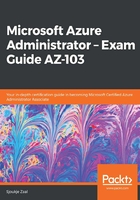
What this book covers
Chapter 1, Managing Azure Subscriptions and Resource Groups, covers how to configure Azure subscriptions and resource groups, assign administrator permissions, configure Azure subscription policies, implement and set tagging on resource groups, configure cost center quotas, configure resource locks, move resources across resource groups, and remove resource groups.
Chapter 2, Analyzing Resource Utilization and Consumption, covers Azure Monitor, including how to create and analyze metric and alerts, create action groups, configure diagnostic settings on resources, use Azure Log Analytics, and utilize Log Search Query functions.
Chapter 3, Managing Role-Based Access Control, covers RBAC, configuring access to Azure resources by assigning roles, configuring management access to Azure, creating a custom role, Azure Policy, and implementing and assigning Azure policies.
Chapter 4, Creating and Configuring Storage Accounts, covers Azure storage accounts, how to create and configure a storage account, install and use Azure Storage Explorer, configure network access to the storage account, generate and manage SAS, and implement Azure storage replication.
Chapter 5, Importing and Exporting Data to Azure, covers how to configure and use Azure Blob storage, how to import into and export from Azure jobs, how to use Azure Content Delivery Network (CDN), how to configure Azure CDN endpoints, and how to use Azure Data Box.
Chapter 6, Configuring Azure Files and Implementing Azure Backup, covers how to create Azure file share and Azure file share sync services, how to use Azure Backup, how to use Azure Site Recovery, how to perform a backup and restore operation, how to create Recovery Services vaults, and creating and configuring a backup policy.
Chapter 7, Creating and Configuring VMs for Windows and Linux, covers VMs, how to deploy Windows and Linux VMs, configuring high availability, deploying and configuring scale sets, and modifying and deploying Azure Resource Manager (ARM) templates.
Chapter 8, Managing Azure VMs and VM Backups, covers how to manage VM sizes, redeploying VMs, moving VMs, adding data disks and network interfaces, automating configuration management, and configuring VM backup and restore.
Chapter 9, Implementing and Managing Virtual Networking, covers Azure VNet, IP addresses, how to configure subnets and VNets, configuring private and public IP addresses, and creating and configuring VNetpeering.
Chapter 10, Integrating On-Premise Networks with Azure Virtual Networks, covers Azure Virtual Private Network (VPN) Gateway, creating and configuring an Azure VPN gateway, creating and configuring a site-to-site VPN, verifying on-premises connectivity, and VNet-to-VNet functionality.
Chapter 11, Monitoring and Troubleshooting Virtual Networking, covers Network Watcher, network resource monitoring, managing virtual network connectivity, monitoring and troubleshooting on-premises connectivity, and managing external networking.
Chapter 12, Azure Security Groups and Azure DNS, covers Network Security Groups (NSGs), how to create and configure an NSG, associating an NSG to a subnet or network interface, creating and evaluating security rules, using Azure DNS, and how to configure private and public DNS zones.
Chapter 13, Implementing Azure Load Balancer, covers Azure Load Balancer, configuring an internal load balancer, creating health probes, creating load balancing rules, and configuring a public load balancer.
Chapter 14, Managing Azure Active Directory, covers Azure AD, how to create and manage users and groups, adding and managing guest accounts, performing bulk user updates, configuring self-service password reset, Azure AD Join, how to manage device settings, and adding custom domains.
Chapter 15, Implementing and Managing Hybrid Identities, covers Azure AD Connect, how to install Azure AD Connect, managing Azure AD Connect, and managing password sync and password writeback.
Chapter 16, Implementing Multi-Factor Authentication, covers Azure MFA, configuring user accounts for MFA, configuring verification methods, configuring fraud alerts, configuring bypass options, and configuring trusted IPs.